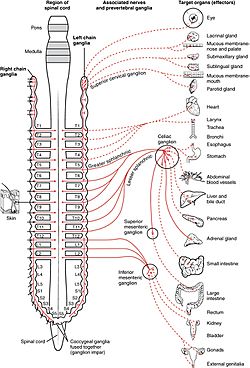Sympathetic nervous system facts for kids
Quick facts for kids Sympathetic nervous system |
|
|---|---|
 |
|
| Schematic illustration showing the sympathetic nervous system with sympathetic cord and target organs. | |
| Latin | pars sympathica divisionis autonomici systematis nervosi |
The Sympathetic nervous system is part of the autonomic nervous system. It becomes more active when you are stressed. It is a part of the "fight or flight" response. The sympathetic nervous system can increase heart rate; make bronchial passages wider; decrease motility (movement) of the large intestine; make blood vessels narrower; increase peristalsis in the esophagus; cause pupil dilation, piloerection (goose bumps) and perspiration (sweating); and raise blood pressure.
Other pages
Images for kids
-
The sympathetic nervous system extends from the thoracic to lumbar vertebrae and has connections with the thoracic, abdominal, and pelvic plexuses.
See also
 In Spanish: Sistema nervioso simpático para niños
In Spanish: Sistema nervioso simpático para niños

All content from Kiddle encyclopedia articles (including the article images and facts) can be freely used under Attribution-ShareAlike license, unless stated otherwise. Cite this article:
Sympathetic nervous system Facts for Kids. Kiddle Encyclopedia.

